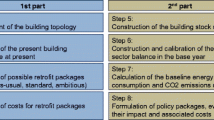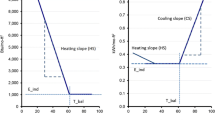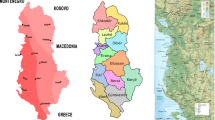Abstract
The residential building stock holds a large energy efficiency improvement potential related to energy upgrading of the building envelope. Details about the heterogeneity of the building stock are paramount to perform a proper assessment of attractive energy efficiency improvements for end-users. Based on a sample of buildings, the study develops methods to identify potentials for heterogeneous building-tailored energy efficiency improvements, to reduce heat consumption, and evaluates their cost-effectiveness in the framework of a district heating area in Denmark. The study accounts for rebound effects and develops both technical (gross) and more realistic (net) potentials, allowing a more accurate analysis of attractive energy efficiency improvements. The analysis is novel as the underlying model relies on building characteristics rather than synthetic archetypes, which can lead to loss of diversity (e.g. in variation of costs and potentials) and thereby discarding cost-effective potentials. The analysis also investigates the sensitivity of the results to assumptions about the discount rate and focuses on the effect of exposing the end-user to different district heating tariffs and the consequent total cost-effective investments. The outcomes show that cost-effective energy efficiency improvements vary considerably, in size and type, among the heterogeneous building stock considered. In regard to district heating tariffs, when all the cost components are variable, the total cost-effective potential increases considerably, with specific energy efficiency improvements distributed differently among building categories, and with the cost components providing different incentives to invest. Heterogeneity, and different tariff policies, thus does matter, when evaluating economically attractive investments in energy efficiency improvements for buildings.















Similar content being viewed by others
Notes
The reader can refer to Section “DH tariff structure in Aarhus” for a thorough explanation of the heat cost pc.
This method assumes constant heat savings throughout the lifetime; hence, it disregards any deterioration of the performances in the long term or any changes in expected occupancy and use of the building, which could impact the level of heat savings (Eleftheriadis and Hamdy 2018).
Clarification note: the values represent energy upgrading opportunity elements (energy efficiency improvements). For instance, considering that there is a total of 12.6 K buildings, and 77.5 K energy efficiency improvements as external walls, on average there are 77.5/12.6≃6.2 external wall renovation opportunities for every building. Nonetheless, differences apply for various building categories.
References
Abdul Hamid, A, Farsäter, K, Wahlström, Å, & Wallentén, P. (2018). Literature review on renovation of multifamily buildings in temperate climate conditions. Energy and Buildings, 172, 414–431.
Affaldvarme Aarhus. (2018). District heating tariffs 2015 (Fjernvarmetakster , in Danish). Accessed 4 Dec 2018. https://affaldvarme.aarhus.dk/erhverv/services/fjernvarme-takster-betaling-og-bestemmelser/takster-fjernvarme-inkl-arkiv/tidligere-aars-takster-for-fjernvarme/2015-takster/.
Affaldvarme Aarhus. (2018). District heating tariffs 2018 (Fjernvarmetakster , in Danish). Accessed 4 Dec 2018. https://affaldvarme.aarhus.dk/media/17034/2018-fjernvarmetakster-abonnement-effekt-og-forbrug-010518-300618.pdf.
Amoruso, G, Donevska, N, & Skomedal, G. (2018). German and Norwegian policy approach to residential buildings’ energy efficiency—a comparative assessment. Energy Efficiency, 11(6), 1375–1395.
Amstalden, RW, Kost, M, Nathani, C, & Imboden, DM. (2007). Economic potential of energy-efficient retrofitting in the Swiss residential building sector: the effects of policy instruments and energy price expectations. Energy Policy, 35, 1819–1829.
Baldini, M, & Trivella, A. (2017). Modelling of electricity savings in the Danish households sector: from the energy system to the end-user. Energy Efficiency, 11, 1563–1581.
Baldini, M, Trivella, A, & Wente, JW. (2018). The impact of socioeconomic and behavioural factors for purchasing energy efficient household appliances: a case study for Denmark. Energy Policy, 120, 503–513.
Baldini, M, & Klinge Jacobsen, H. (2016). Optimal trade-offs between energy efficiency improvements and additional renewable energy supply: a review of international experiences. IEEExplore.
Ballarini, I, Corrado, V, Madonna, F, Paduos, S, & Ravasio, F. (2017). Energy refurbishment of the Italian residential building stock: energy and cost analysis through the application of the building typology. Energy Policy, 105, 148–160.
Ben-Amer-Allam, S, Münster, M, & Petroviá, S. (2017). Scenarios for sustainable heat supply and heat savings in municipalities - the case of Helsingør, Denmark. Energy, 137, 1252–1263.
Booth, AT, Choudhary, R, & Spiegelhalter, DJ. (2012). Handling uncertainty in housing stock models. Building and Environment, 48(1), 35–47.
Brøgger, M, Bacher, P, & Wittchen, KB. (2019). A hybrid modelling method for improving estimates of the average energy-saving potential of a building stock. Energy and Buildings, 199, 287–296.
Brøgger, M, Bacher, P, Madsen, H, & Wittchen, KB. (2018). Estimating the influence of rebound effects on the energy-saving potential in building stocks. Energy and Buildings, 181, 62–74.
Brøgger, M, & Wittchen, KB. (2016). Energy performance certificate classifications across shifting frameworks. Procedia Engineering, 161, 845–849.
Brøgger, M, & Wittchen, KB. (2017). Flexible building stock modelling with array-programming data description method – array-based programming. In Barnaby, CS, & Wetter, M (Eds.) Proceedings of the 15th IBPSA Conference San Francisco, CA, USA, Aug. 7-9, 2017. http://www.ibpsa.org/proceedings/BS2017/BS2017_272.pdf (pp. 1027–1036): International Building Performance Simulation Association.
Brøgger, M, & Wittchen, KB. (2018). Estimating the energy-saving potential in national building stocks – a methodology review. Renewable and Sustainable Energy Reviews, 82, 1489–1496.
Burgett, JM, Chini, AR, & Oppenheim, P. (2013). Specifying residential retrofit packages for 30 % reductions in energy consumption in hot–humid climate zones. Energy Efficiency, 6(3), 523–543.
Danish Utility Regulator. (2020). District heating price statistics (Prisstatistik, in Danish). Accessed 22 Feb 2020. https://forsyningstilsynet.dk/tal-fakta/priser/varmepriser/priser-pr-1-august-2018,.
Danmark NationalBank. (2020). Official interest rates. Accessed 22 Feb 2020. http://www.nationalbanken.dk/en/marketinfo/official_interestrates/Pages/default.aspx.
Djørup, SR, Sperling, K, Nielsen, S, Østergaard, PA, Thellufsen, JZ, Sorknæs, P, Lund, H, & Drysdale, DW. (2020). District heating tariffs, economic optimisation and local strategies during radical technological change. Energies 13(5).
Ekström, T, Bernardo, R, & Blomsterberg, Å. (2018). Cost-effective passive house renovation packages for Swedish single-family houses from the 1960s and 1970s. Energy and Buildings, 161, 89–102.
Eleftheriadis, G, & Hamdy, M. (2018). The impact of insulation and HVAC degradation on overall building energy performance: a case study. Buildings, 8, 23.
EN ISO. (2008). 13790: energy performance of buildings – calculation of energy use for space heating and cooling (EN ISO 13790: 2008). European Committee for Standardization (CEN), Brussels 2006 (50).
European Commision. (2010). Directive 2010/31/EU of the European Parliament and of the Council of 19 May 2010 on the energy performance of buildings (recast). Accessed 4 Dec 2018. http://www.buildup.eu/en/node/9631.
European Commision. (2012). Commission delegated regulation (EU) No 244/2012. Accessed 4 Dec 2018.
European Commission. (2018). Buildings - European Commission. Accessed 4 Dec 2018. https://ec.europa.eu/energy/en/topics/energy-efficiency/buildings.
Felius, LC, Dessen, F, & Hrynyszyn, BD. (2020). Retrofitting towards energy-efficient homes in European cold climates: a review. Energy Efficiency, 13(1), 101–125.
Forsygnings og Klimaministeriet. (2018). Energy Saving Order - Executive Order on Energy Saving Services in Network and Distribution Companies (Energisparebekendtgørelsen - Bekendtgørelse om energispareydelser i net- og distributionsvirksomheder, in Danish). Accessed 4 Dec 2018. https://www.retsinformation.dk/Forms/R0710.aspx?id=201210.
Forsynings og Klimaministeriet. (2015). Energy Policy Recommendations (Energipolitisk redegørelse, in Danish). Accessed 4 Dec 2018. https://www.efkm.dk/media/8073/energipolitisk_redegoerelse_2015.pdf.
Galvin, R. (2014). Making the ‘rebound effect’ more useful for performance evaluation of thermal retrofits of existing homes: Defining the ‘energy savings deficit’ and the ‘energy performance gap’. Energy and Buildings, 69, 515–524.
Galvin, R, & Sunikka-Blank, M. (2016). Quantification of (p)rebound effects in retrofit policies - Why does it matter? Energy, 95, 415–424.
Gaterell, MR, & McEvoy, ME. (2005). The impact of energy externalities on the cost effectiveness of energy efficiency measures applied to dwellings. Energy and Buildings, 37, 1017–1027.
Haas, R, Auer, H, & Biermayr, P. (1998). The impact of consumer behavior on residential energy demand for space heating. Energy and Buildings, 27(2), 195–205.
Hens, H, Parijs, W, & Deurinck, M. (2010). Energy consumption for heating and rebound effects. Energy and Buildings, 42(1), 105–110.
Hermelink, AH, & De Jager, D. (2015). Evaluating our future: the crucial role of discount rates in European Commission energy system modelling. Tech. rep., The European Council for an Energy Efficient Economy. Accessed 22 Feb 2020. https://www.eceee.org/policy-areas/discount-rates/evaluating-our-future-report/.
Hvelplund, F, Krog, L, Nielsen, S, Terkelsen, E, & Madsen, KB. (2019). Policy paradigms for optimal residential heat savings in a transition to 100% renewable energy systems. Energy Policy, 134, 110944.
Jensen, PA, Maslesa, E, Berg, JB, & Thuesen, C. (2018). 10 questions concerning sustainable building renovation. Building and Environment, 143, 130–137.
Kragh, J, & Wittchen, KB. (2014). Development of two Danish building typologies for residential buildings. Energy and Buildings, 68, 79–86.
Krarti, M, & Dubey, K. (2018). Review analysis of economic and environmental benefits of improving energy efficiency for UAE building stock. Renewable and Sustainable Energy Reviews, 82, 14–24.
Lechtenböhmer, S, & Schüring, A. (2011). The potential for large-scale savings from insulating residential buildings in the EU. Energy Efficiency, 4(2), 257–270.
Lešnik, M, Premrov, M, & žegarac Leskovar, V. (2018). Design parameters of the timber-glass upgrade module and the existing building: impact on the energy-efficient refurbishment process. Energy, 162, 1125–1138.
Majcen, D, Itard, L, & Visscher, H. (2013). Actual and theoretical gas consumption in Dutch dwellings: what causes the differences? Energy Policy, 61, 460–471.
Majcen, D, Itard, L, & Visscher, H. (2016). Actual heating energy savings in thermally renovated Dutch dwellings. Energy Policy, 97, 82–92.
Mata, E, Sasic Kalagasidis, A, & Johnsson, F. (2015). Cost-effective retrofitting of Swedish residential buildings: effects of energy price developments and discount rates. Energy Efficiency, 8(2), 223–237.
Molio.dk. (2018). Molio. Accessed 4 Dec 2018. https://molio.dk/.
Ó Broin, E, Mata, E, Nässén, J, & Johnsson, F. (2015). Quantification of the energy efficiency gap in the Swedish residential sector. Energy Efficiency, 8(5), 975–993.
Santangelo, A, Yan, D, Feng, X, & Tondelli, S. (2018). Renovation strategies for the Italian public housing stock: applying building energy simulation and occupant behaviour modelling to support decision-making process. Energy and Buildings, 167, 269–280.
Sarran, L, Hviid, CA, & Rode, C. (2020). Correlation between perceived usability of building services and indoor environmental satisfaction in retrofitted low-energy homes. Building and Environment, 179, 106946.
Sernhed, K, Gåverud, H, & Sandg, A. (2017). Customer perspectives on district heating price models. International Journal of Sustainable Energy Planning and Management, 13 (2017), 47–60 (English).
Steinbach, J, & Staniaszek, D. (2015). Discount rates in energy system analysis. Tech. rep., Buildings Performance Institute Europe (BPIE), Fraunhofer ISI. Accessed 4 Dec 2018. http://bpie.eu/publication/discount-rates-in-energy-system-analysis/.
Swan, LG, & Ugursal, VI. (2009). Modeling of end-use energy consumption in the residential sector: a review of modeling techniques. Renewable and Sustainable Energy Reviews, 13(8), 1819–1835.
TABULA Project Team. (2012). Typology approach for building stock energy assessment - main results of the TABULA project. Tech. Rep. June 2009 Institute Wohnen und Umwelt GmbH. Accessed 4 Dec 2018. https://ec.europa.eu/energy/intelligent/projects/en/projects/tabula.
Tommerup, H, & Svendsen, S. (2006). Energy savings in Danish residential building stock. Energy and Buildings, 38, 618–626.
Trafik-, Bygge- og Boligstyrelsen. (2018). Building Regulation 2015 (Bygningsreglementet, in Danish). Accessed 6 June 2020. https://historisk.bygningsreglementet.dk/br15_03_id107/0/42/1.
Trafik-, Bygge- og Boligstyrelsen. (2018). Building Regulation 2018 (Bygningsreglementet, in Danish). Accessed 4 Dec 2018. https://bygningsreglementet.dk/Tekniske-bestemmelser/11/BRV/Energiforbrug/Kap-1_1.
Wittchen, KB, Kragh, J, & Aggerholm, S. (2017). Heat saving in existing buildings - potential and economy (Varmebesparelse i eksistemende bygninger - potentiale og økonomi, in Danish). Tech. rep., Danish Building Research Institute, Copenhagen, Denmark. Accessed 4 Dec 2018. https://sbi.dk/Assets/Varmebesparelse-i-eksisterende-bygninger/SBi-2017-16.pdf.
Zegarac Leskovar, V, Premrov, M, & Lešnik, M. (2019). Integrative approach to comprehensive building renovations. Berlin: Springer.
Zvingilaite, E. (2013). Modelling energy savings in the Danish building sector combined with internalisation of health related externalities in a heat and power system optimisation model. Energy Policy, 55, 57–72.
Zvingilaite, E, & Balyk, O. (2014). Heat savings in buildings in a 100% renewable heat and power system in Denmark with different shares of district heating. Energy and Buildings, 82, 173–186.
Zvingilaite, E, & Klinge Jacobsen, H. (2015). Heat savings and heat generation technologies: Modelling of residential investment behaviour with local health costs. Energy Policy, 77, 31–45.
Acknowledgements
Many thanks to Stefan Petrovic, Vignesh Krishnamoorthy and Daniel Sneum Møller for the fruitful discussions, which has surely enhanced the quality of the manuscript.
Funding
The research has been financed by Innovation Fund Denmark under the research project SAVE-E, grant no. 4106-00009B.
Author information
Authors and Affiliations
Corresponding author
Additional information
Publisher’s note
Springer Nature remains neutral with regard to jurisdictional claims in published maps and institutional affiliations.
Rights and permissions
About this article
Cite this article
Baldini, M., Brøgger, M., Jacobsen, H.K. et al. Cost-effectiveness of energy efficiency improvements for a residential building stock in a Danish district heating area. Energy Efficiency 13, 1737–1761 (2020). https://doi.org/10.1007/s12053-020-09889-x
Received:
Accepted:
Published:
Issue Date:
DOI: https://doi.org/10.1007/s12053-020-09889-x




